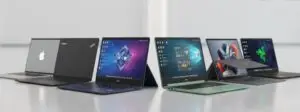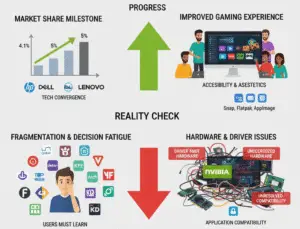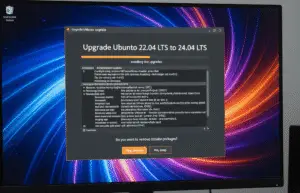
Neuromorphic Computing in 2025: The Brain-Inspired Tech Revolution

Introduction: Computers That Think Like Us
Imagine a computer chip that works like the human brain – learning instantly, using minimal power, and recognizing patterns effortlessly. This is neuromorphic computing, and by 2025, it will power everything from smarter smartphones to autonomous robots that learn on the fly.
This easy-to-understand guide explains:



Neuromorphic Computing: Your Brain as a Blueprint for Future Tech
Imagine if your smartphone could learn like you do – getting better at recognizing your voice, conserving battery like your brain conserves energy, and handling multiple tasks effortlessly. That’s the promise of neuromorphic computing, a revolutionary approach to building computer chips that work more like human brains than traditional computers.
How It’s Different From Regular Computing:
-
Learning vs. Programming
-
Traditional chips: Follow rigid instructions (like a recipe)
-
Neuromorphic chips: Learn from experience (like a child)
-
Example: Intel’s Loihi chip learned to recognize 10 different smells with just one sample each – something impossible for conventional AI
-
-
Parallel Processing Power
-
Regular computers: Do tasks one after another (like taking notes with one hand)
-
Brain-like chips: Handle multiple inputs simultaneously (like juggling while having a conversation)
-
Real-world use: Processing camera, radar and lidar data together for self-driving cars
-
-
Energy Efficiency
-
Your brain uses about 20 watts (like a dim light bulb)
-
Current AI models can use enough energy to power a small town
-
Breakthrough: IBM’s neuromorphic chip achieved 1/1000th the energy use of conventional chips for certain tasks
-
Where You’ll See It First:
-
Smartphones that truly understand your habits
-
Medical devices that adapt to patients’ unique biology
-
Security cameras that spot anomalies without constant monitoring
-
Coming soon: Brain implants that help paralyzed patients communicate
Why This Matters:
While today’s AI can beat humans at chess, it takes a massive data center to do what your brain does on sandwich power. Neuromorphic computing could put that capability in your pocket – learning and adapting without draining your battery or needing constant internet updates.
The Trade-Offs:
-
Still in early stages (like computers in the 1950s)
-
Works differently than what programmers are used to
-
Raises new questions about how “thinking” machines should behave
Brain vs. Computer: Key Differences
| Feature | Traditional Computers | Neuromorphic Chips |
|---|---|---|
| Processing | Linear (step-by-step) | Parallel (all at once) |
| Learning | Needs reprogramming | Learns from experience |
| Power Use | High (needs cooling) | Extremely low (like a brain) |
5 Groundbreaking Applications Coming by 2025
1. Always-Learning Smartphones
2025 Vision: Phones that:
-
Instantly recognize your voice/face (no “training” needed)
-
Adapt to your habits automatically
-
Use 10x less battery for AI tasks
Current Example:
Intel’s Loihi 2 chip processes visual data 1000x more efficiently than regular chips
2. Real-Time Health Monitors
Medical Breakthroughs:
-
Wearables that detect seizures before they happen
-
Smart bandages analyzing wounds continuously
Working Prototype:
Stanford’s brain-inspired chip analyzing ECG signals with 95% accuracy
3. Autonomous Robots That Learn
New Abilities:
-
Household robots adapting to your preferences
-
Factory robots learning new tasks in minutes
Real-World Example:
iCub robot learning object manipulation like a human child
4. Ultra-Efficient AI Assistants
Coming Changes:
-
Alexa that understands context like a human
-
No more “I didn’t catch that” errors
Tech Behind It:
IBM’s TrueNorth chip processes natural language using just 70 milliwatts
5. Edge AI Everywhere
What It Means:
-
Security cameras recognizing threats locally (no cloud needed)
-
Cars making instant driving decisions
2025 Impact:
Reducing AI response times from seconds to milliseconds
Neuromorphic Computing Demystified: How Brain-Like Chips Actually Work
Imagine computer chips that don’t compute – they think. Here’s the fascinating way neuromorphic technology mimics our brains:
1. Artificial Neurons: The Building Blocks
-
Each neuron is a microscopic processor that can:
-
Receive signals (like hearing a familiar voice)
-
Decide if the input is important enough to respond to
-
Send signals to other neurons
-
-
Example: Intel’s Loihi 2 chip packs 1 million neurons on something smaller than a dime
2. Spiking Neural Networks: The Language of Thought
-
Unlike regular computers that use 1s and 0s:
-
Neurons communicate through precise electrical pulses (“spikes”)
-
The timing between spikes carries meaning
-
Real-world analogy: Morse code, but where the spaces between dots/dashes matter as much as the signals themselves
-
3. On-Chip Learning: Instant Adaptation
-
Traditional AI needs massive data centers for learning
-
Neuromorphic chips learn locally:
-
Adjust connections between neurons in real-time
-
Remember patterns directly on the chip
-
Example: A neuromorphic security camera could learn your family’s faces without ever connecting to the cloud
-
4. Parallel Processing: The Brain’s Superpower
-
While your laptop does tasks sequentially (A→B→C)
-
Neuromorphic chips handle everything at once:
-
Seeing while listening while making decisions
-
Comparison: Like a chef who can chop, stir and taste simultaneously vs. a cook who must finish one task before starting another
-
Mind-Blowing Capabilities:
-
A research chip recognized handwritten digits with 95% accuracy using just 1/80,000th the energy of a conventional AI system
-
Some experimental systems can process sensory data 1000x faster than traditional chips
-
Future applications could include:
-
Smart glasses that learn and recognize objects for the visually impaired
-
Factory robots that adapt to new tasks without reprogramming
-
Pacemakers that anticipate heart irregularities before they happen
-
The Tradeoffs:
-
Not great for traditional computing tasks (like spreadsheets)
-
Requires completely new programming approaches
-
Still can’t match the full complexity of biological brains (yet!)
Fun Fact: Some neuromorphic systems actually work better when slightly “sleep-deprived” – mimicking how human brains sometimes find creative solutions when tired!*
Why This Matters to You
For Tech Users:
-
Phones that last days, not hours
-
Truly intelligent smart home devices
For Businesses:
-
AI that doesn’t require massive data centers
-
Real-time decision making anywhere
For the Planet:
-
Could reduce AI’s energy use by 90%
-
Enables AI on solar-powered devices
The Next Frontier: How Neuromorphic Computing Will Transform Our World After 2025
1. Brain-Computer Interfaces That Feel Natural
By 2030, we’ll see the first consumer-grade neural interfaces that:
-
Work like a sixth sense: Imagine thinking “turn on lights” and your smart home responds
-
Restore abilities: Paralysis patients controlling exoskeletons as naturally as their own limbs
-
Learn with you: Devices that adapt to your unique thought patterns over time
Example: Precision Neuroscience’s implant already helps stroke victims communicate at 90+ words per minute
2. Ambient AI – Your Invisible Assistant
Future environments will:
-
Anticipate needs: Your office automatically adjusts lighting/temperature as your focus changes
-
Enable frictionless living: Walk into stores where payment happens automatically
-
Protect subtly: Smart sidewalks detect when elderly might fall and alert caregivers
Coming soon: Delta Airlines testing AI lounges that adjust services based on passenger stress levels
3. Cognitive Cities That Think
Urban infrastructure will become living systems that:
-
Self-repair: Bridges with “nervous systems” that detect and report micro-fractures
-
Adapt in real-time: Traffic systems that learn weekend festival patterns by Saturday afternoon
-
Evolve democratically: City planning AIs that incorporate citizen feedback continuously
Pioneer: Dubai’s 2031 AI strategy aims to eliminate all government paperwork
The Big Picture Shift:
We’re moving from:
-
Smart → Cognitive
-
Connected → Intuitive
-
Automated → Adaptive
Potential Concerns:
-
The “always learning” dilemma – when should devices forget?
-
New digital divide – those who can vs can’t afford neural interfaces
-
Maintaining human agency in decision-making
A Day in 2035:
Your morning begins with your sleep-optimized apartment gradually brightening to match your circadian rhythm. As you think about coffee, the kitchen starts brewing. Walking downtown, the crosswalk holds the light because it senses your hurried pace. Your neural interface discreetly reminds you about an appointment it noticed you forgetting – all while using less power than today’s wireless earbuds.
How to Track the Neuromorphic Computing Revolution (Without Becoming a Scientist)
1. Join the Neuromorphic Community
Where to start:
-
Intel’s Neuromorphic Research Community (free to join) – Get monthly updates on real-world applications
-
BrainChip’s Developer Program – For hands-on experimenters
-
IEEE Brain Initiative – Professional-grade resources made accessible
Pro tip: These groups often offer virtual “demo days” where companies showcase breakthrough prototypes
2. Decode Tech Announcements
What to watch for:
-
“Event-based processing” – Techspeak for brain-like chips (e.g., Sony’s vision sensors)
-
“Spiking neural networks” – The telltale sign of neuromorphic tech
-
“Sub-1-watt AI” – The energy efficiency benchmark
Recent example: Samsung’s 2024 “Exynos with NPU” announcement actually hinted at neuromorphic features
3. Spot Consumer Applications
In upcoming devices:
-
Phones that gain battery life when using AI features
-
Smartwatches with always-on health monitoring
-
Home security cameras that learn normal vs suspicious activity
Try this: When reviewing tech specs, look for “on-device learning” – a hallmark of neuromorphic approaches
4. Follow the Right Voices
On LinkedIn:
-
Professor Giacomo Indiveri (University of Zurich)
-
“Neuromorphic Engineers” channel breaks down complex concepts
Warning: Avoid “brain chip hype” accounts – real progress is quieter but more substantial
5. Hands-On Exploration
For the curious:
-
Intel’s Kapoho Point ($99 starter kit)
-
BrainChip’s Akida Development Kit
-
Open-source projects like Nengo for software simulation
No coding required: Many tools now have drag-and-drop interfaces
What to Expect in 2024-2025:
-
First laptops boasting “10x longer AI battery life”
-
Smart appliances that adapt to your habits out of the box
-
Major automakers revealing neuromorphic co-processors
Remember: This isn’t another tech fad. The companies investing here (Intel, IBM, Samsung) are betting big on neuromorphic as the future of computing. The trick is spotting the real advances amid the hype.
Final Thought: Computing’s Evolutionary Leap
Neuromorphic computing doesn’t just make faster computers – it creates machines that learn and think in fundamentally new ways. By 2025, this brain-inspired technology may quietly become the backbone of our AI-powered world.
Neuromorphic Computing: Your Questions Answered
Q: Is this like quantum computing? They both sound futuristic…
A: They’re completely different approaches:
-
Quantum computing harnesses quantum physics (think: atoms behaving in strange ways)
-
Good for: Breaking encryption, simulating molecules
-
Example: Google’s quantum computer that solved in minutes what would take regular computers thousands of years
-
-
Neuromorphic computing copies biology (think: artificial brain cells)
-
Good for: Sensory processing, adaptive learning
-
Example: BrainChip’s neuromorphic processor for smart cameras
-
Q: When will this show up in my gadgets?
A: The rollout has already begun:
-
2024: Specialized industrial sensors and medical devices
-
Example: Cochlear implants that adapt to users’ hearing patterns
-
-
*2025-2026:* Consumer electronics starting with:
-
Always-on voice assistants in phones that don’t drain batteries
-
Smart home devices that learn your routines without cloud computing
-
-
Fun fact: Some Tesla vehicles already use limited neuromorphic processing for their self-driving systems
Q: Will this replace my laptop and phone?
A: Not exactly – think of it as adding a new tool:
-
Traditional computers still rule for:
-
Spreadsheets
-
Video editing
-
Web browsing
-
-
Neuromorphic chips will excel at:
-
Real-time translation
-
Context-aware suggestions
-
Sensor processing
-
-
Future combo: Your phone might use regular chips for apps but neuromorphic chips for camera processing and voice control
Bonus Q: Can these chips “think” like humans?
A: Not quite – but they’re getting closer to how we learn:
-
They still lack consciousness or understanding
-
But they can recognize patterns with human-like efficiency
-
Example: A neuromorphic security system might notice “something’s wrong” the way you intuitively sense when a room feels off
Q: Are there any risks?
A: Like any powerful tech:
-
Privacy concerns with devices that learn constantly
-
Potential for manipulation if the learning isn’t secure
-
Silver lining: Because they operate differently, they’re naturally resistant to many conventional hacking methods
The bottom line? Neuromorphic computing won’t replace traditional computers but will give them capabilities we’ve only seen in biology – making our devices more intuitive, efficient, and surprisingly human-like in how they process information. Would you prefer a device that computes or one that learns? Soon, you might not have to choose.




